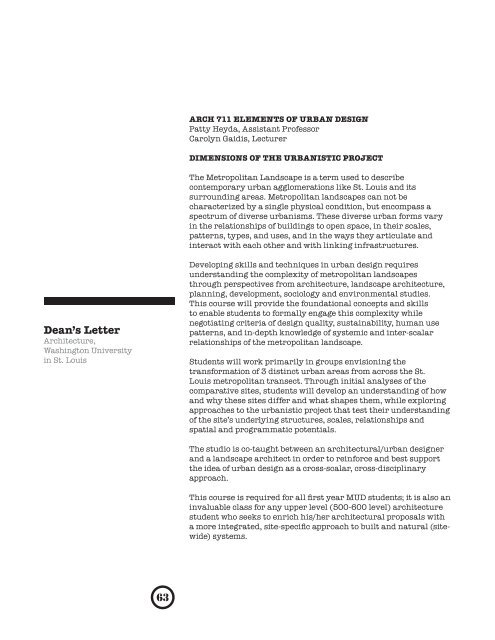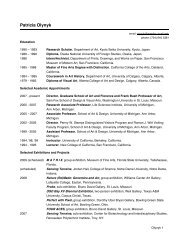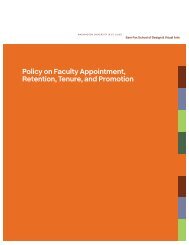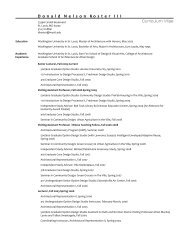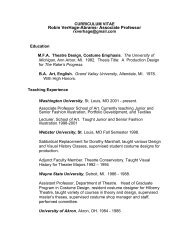architecture - Sam Fox School - Washington University in St. Louis
architecture - Sam Fox School - Washington University in St. Louis
architecture - Sam Fox School - Washington University in St. Louis
Create successful ePaper yourself
Turn your PDF publications into a flip-book with our unique Google optimized e-Paper software.
Dean’s Letter<br />
Architecture,<br />
<strong>Wash<strong>in</strong>gton</strong> <strong>University</strong><br />
<strong>in</strong> <strong>St</strong>. <strong>Louis</strong><br />
63<br />
ARCH 711 ELEMENTS OF URBAN DESIGN<br />
Patty Heyda, Assistant Professor<br />
Carolyn Gaidis, Lecturer<br />
DIMENSIONS OF THE URBANISTIC PROJECT<br />
The Metropolitan Landscape is a term used to describe<br />
contemporary urban agglomerations like <strong>St</strong>. <strong>Louis</strong> and its<br />
surround<strong>in</strong>g areas. Metropolitan landscapes can not be<br />
characterized by a s<strong>in</strong>gle physical condition, but encompass a<br />
spectrum of diverse urbanisms. These diverse urban forms vary<br />
<strong>in</strong> the relationships of build<strong>in</strong>gs to open space, <strong>in</strong> their scales,<br />
patterns, types, and uses, and <strong>in</strong> the ways they articulate and<br />
<strong>in</strong>teract with each other and with l<strong>in</strong>k<strong>in</strong>g <strong>in</strong>frastructures.<br />
Develop<strong>in</strong>g skills and techniques <strong>in</strong> urban design requires<br />
understand<strong>in</strong>g the complexity of metropolitan landscapes<br />
through perspectives from <strong>architecture</strong>, landscape <strong>architecture</strong>,<br />
plann<strong>in</strong>g, development, sociology and environmental studies.<br />
This course will provide the foundational concepts and skills<br />
to enable students to formally engage this complexity while<br />
negotiat<strong>in</strong>g criteria of design quality, susta<strong>in</strong>ability, human use<br />
patterns, and <strong>in</strong>-depth knowledge of systemic and <strong>in</strong>ter-scalar<br />
relationships of the metropolitan landscape.<br />
<strong>St</strong>udents will work primarily <strong>in</strong> groups envision<strong>in</strong>g the<br />
transformation of 3 dist<strong>in</strong>ct urban areas from across the <strong>St</strong>.<br />
<strong>Louis</strong> metropolitan transect. Through <strong>in</strong>itial analyses of the<br />
comparative sites, students will develop an understand<strong>in</strong>g of how<br />
and why these sites differ and what shapes them, while explor<strong>in</strong>g<br />
approaches to the urbanistic project that test their understand<strong>in</strong>g<br />
of the site’s underly<strong>in</strong>g structures, scales, relationships and<br />
spatial and programmatic potentials.<br />
The studio is co-taught between an architectural/urban designer<br />
and a landscape architect <strong>in</strong> order to re<strong>in</strong>force and best support<br />
the idea of urban design as a cross-scalar, cross-discipl<strong>in</strong>ary<br />
approach.<br />
This course is required for all first year MUD students; it is also an<br />
<strong>in</strong>valuable class for any upper level (500-600 level) <strong>architecture</strong><br />
student who seeks to enrich his/her architectural proposals with<br />
a more <strong>in</strong>tegrated, site-specific approach to built and natural (sitewide)<br />
systems.


